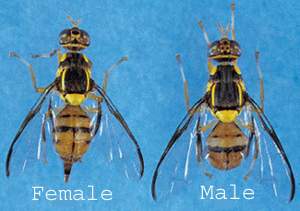A proposed rule is open for public comment that would allow the importation of apples into US markets from China.
A pest risk assessment has identified 21 pests that are on US quarantine lists which could be introduced in/on apples from China. Assurances have been made that fruit will be inspected prior to harvest for signs of infestation and fumigated prior to entrance into the US. However, the importation of fruit increases the likelihood that pests, such as the Oriental Fruit Fly, the plum fruit moth and the summer fruit tortrix, could be accidentally introduced and become established.
You may submit comments electronically by visiting http://www.regulations.gov/#!docketDetail;D=APHIS-2014-0003

Oriental Fruit Fly
The Oriental Fruit Fly has 150+ host plants including peach and apple and has been accidentally introduced into the US on many occasions. These accidental introductions initiated eradication efforts at the site of entry and detection. The plum fruit moth is also on the quarantine list and is a serious pest of stone fruits in Asia and Europe. Like its relative, the Codling moth, its larvae tunnel into fruit to develop. A third pest of concern is the summer fruit tortrix. This is listed as an exotic of HIGH risk to the US and feeds on over 50 plant hosts, including pome and stone fruit, hardwood trees and grapes. The summer fruit tortrix is a leafroller pest and attacks leaves, shoots and fruits, reducing the quality and quantity of fruit as well as increasing susceptibility to diseases.

Summer Fruit Tortrix Larvae
Invasive species are organisms that are not native to the region and become significant pests. Our diverse agroecosystem and numerous wild hosts, including native and those of European and Asian origin can further increase the success in our region. In tree fruit, we already have many examples of successful invasive pests, including Brown Marmorated Stink Bug, Oriental Fruit Moth, San Jose scale to name a few. BMSB was likely accidentally introduced through infested shipping containers from a small number of individuals while both OFM and SJS came through on infested trees or rootstocks. When foreign insects are introduced they frequently do not have their natural enemies present to keep them under natural levels of control and this allows the populations to increase without check. As you know, they can be very difficult to manage under IPM programs and can be financially devastating.
You may submit comments electronically by visiting http://www.regulations.gov/#!docketDetail;D=APHIS-2014-0003

